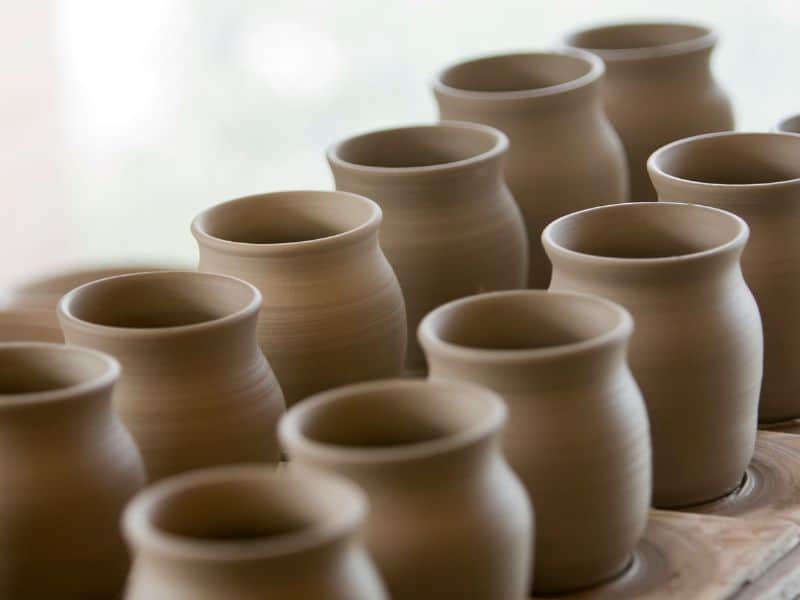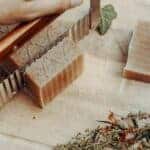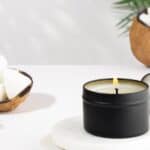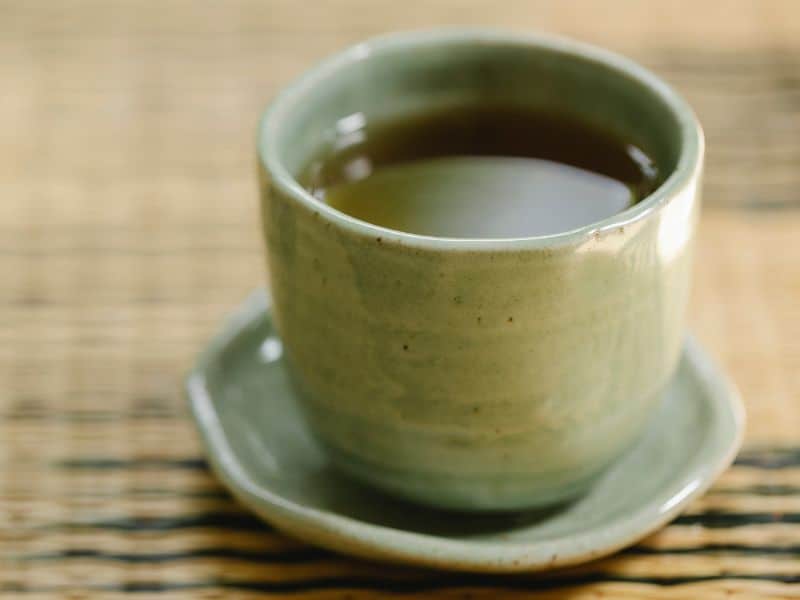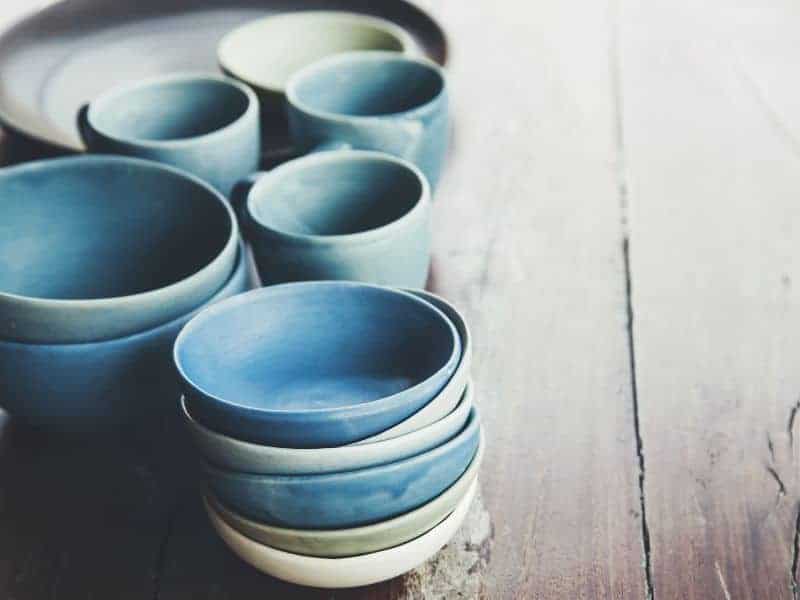When making a piece of pottery, you have to understand how to dry and fire clay. This article will explain these processes in a simple and easy-to-understand way. We’ll also talk about the different types of clay you can use and how they affect your pottery. So, can pottery be too dry to fire?
Pottery cannot be too dry to fire. However, pottery that is excessively dry can become very brittle. It should be handled with care to avoid breakage. If a piece has been left to dry for a long time, it’s a good idea to dampen it slightly before firing.
This can help prevent cracking during the firing process. So, what happens if you don’t dampen a piece that’s been left to dry for a long time? Well, when it’s fired in the kiln, the heat can cause the overly dry clay to crack or even explode.
The problem is that you do not wan’t the pottery to be too dry or to be too wet.
This is because the heat creates stress within the clay body, and if the clay is too dry, it can’t handle that stress. Dampening the clay slightly before firing allows it to better withstand the heat, reducing the risk of cracking or exploding.
Remember, pottery is a delicate balance of moisture and heat, and understanding this balance is key to successful pottery making. Let’s take a closer look at this below.
What Role Does Drying Play in Firing Pottery?
Drying plays a crucial role in pottery firing. It removes moisture from the clay, preventing cracking or explosion in the kiln due to steam pressure. Proper drying ensures the clay can withstand the high temperatures of firing, leading to successful pottery creation.
Pottery, an ancient art form, hinges on two key processes: drying and firing. These stages transform wet clay into a sturdy, finished piece of art. Understanding these processes is not just beneficial, it’s essential.
It’s the knowledge that empowers you to prevent common pottery mishaps such as cracking, exploding in the kiln, or warping during the drying process.
In essence, a thorough understanding of drying and firing processes leads to better outcomes in pottery making, enhancing the quality of the final product.
What Does the Pottery Drying and Firing Process Involve?
The drying and firing process involves several stages. First, the wet clay is shaped into the desired form. Then, it’s left to dry. This stage removes the water content from the clay, preparing it for firing. The firing process involves heating the dried clay in a kiln. This process hardens the clay, transforming it into a finished pottery piece.
Why is Understanding the Drying and Firing Process Important?
Understanding the drying and firing process is crucial for successful pottery making. It helps you prevent common issues such as cracking or exploding in the kiln.
It also allows you to control the final appearance and durability of your pottery piece. By mastering these processes, you can create high-quality pottery pieces that are both beautiful and durable.
What is The Clay Body in Pottery?
The clay body is the raw material in pottery. It’s a complex mixture of tiny clay particles, often including ball clay, known for its excellent plasticity and green strength, making it a preferred choice for pottery.
Understanding the composition of the clay body provides insights into how it behaves during the drying and firing processes.
What Are the Components of the Clay Body?
The clay body consists of tiny clay particles. These particles are bound together by water, forming a malleable material. Ball clay is often used in pottery due to its high plasticity. This property makes it easy to shape and mold, making it ideal for creating intricate pottery designs.
What Types of Clay are Commonly Used in Pottery?
There are various types of clay used in pottery. Each type has unique properties that affect the drying and firing processes. For instance, earthenware clay is suitable for low-temperature firing, while stoneware and porcelain clays can withstand higher temperatures. The type of clay you choose will depend on the desired look and feel of your final pottery piece.
How Does the Clay Body React to Drying and Firing?
During drying and firing, the clay body undergoes significant changes. It shrinks as the water content evaporates, and it hardens when exposed to high temperatures in the kiln. These transformations are fascinating and understanding them is crucial for any potter.
What Does the Pottery Drying Process Entail?
The drying process is the first critical stage after a potter shapes their piece. It’s a delicate phase that prepares the clay for the intense heat of the kiln.
Drying involves the slow and careful removal of water from the clay. Rapid drying can cause cracks or warping, ruining the piece.
What Steps are Involved in the Drying Process?
The drying process involves several steps. First, the shaped clay is left to dry at room temperature. It’s important to ensure that the drying process is slow and even to prevent cracking.
Using plastic bags or wrapping the piece in paper towels can help maintain even moisture levels. Once the clay is bone dry, it’s ready for the first firing.
Why is Drying Before Firing Crucial?
Drying before firing is essential. It’s a safeguard against the pottery piece exploding in the kiln, a disaster caused by steam pressure from water trapped in the clay. If the clay is not thoroughly dry, the water turns into steam in the kiln.
The steam then expands, causing the pottery piece to explode. This not only destroys the piece but can also damage other pieces in the kiln.
What Factors Influence the Drying Process?
Several factors influence the drying process. Room temperature and humidity, for instance, can speed up or slow down drying. In a humid climate, drying takes longer.
Conversely, in a dry, hot climate, pieces may dry too quickly, leading to cracks. The thickness of the piece also affects the drying time. Thicker pieces take longer to dry than thinner ones.
How Do Plastic Bags and Paper Towels Aid Drying?
Plastic bags and paper towels play a crucial role in controlling the drying process. They help maintain even moisture levels throughout the piece, preventing the formation of stress cracks. Wrapping a piece in a plastic bag slows down the drying process, allowing moisture to evenly distribute throughout the piece. Paper towels can be used to gently absorb excess moisture from the surface.
How Long Should Pottery Dry Before Firing?
The drying time for pottery depends on several factors, including the thickness of the piece and the ambient conditions. Generally, it takes one to two weeks for a piece to dry thoroughly. However, in a humid climate, it may take longer. It’s important to ensure that the piece is completely dry before firing to prevent cracking or exploding in the kiln.
What are the Effects of Uneven Drying on Pottery?
Uneven drying can cause serious problems. It can lead to warping or cracking, ruining the piece. Therefore, it’s important to ensure that pottery dries evenly. This can be achieved by rotating the piece during the drying process and by using plastic bags or paper towels to control the drying rate.
What Happens During the Pottery Firing Process?
The firing process is where the magic happens. It’s where the dried clay piece is transformed into a durable, finished pottery piece. This process involves heating the piece in a kiln to high temperatures.
What Does the Firing Process Involve?
The firing process involves several stages. The first stage is the bisque firing. This is a low-temperature firing that hardens the clay and makes it less fragile. After bisque firing, the piece is glazed and then fired again at a higher temperature.
This second firing, known as glaze firing, melts the glaze, giving the piece a glassy surface.
What are the Different Stages of Firing?
There are two main stages of firing: bisque firing and glaze firing. Bisque firing is the first firing. It hardens the clay and prepares it for glazing. Glaze firing is the second firing.
It melts the glaze, giving the piece a shiny, glass-like surface. Each stage has a specific temperature range. The exact temperatures depend on the type of clay and glaze used.
How Do Electric KilnsAid the Firing Process?
Electric kilns play a vital role in the firing process. They provide a controlled environment where the temperature can be precisely regulated. This allows for consistent results, which is especially important during glaze firing.
Electric kilns are also safer and easier to use than traditional wood-fired or gas kilns, making them a popular choice for hobbyists and professional potters alike.
How Do Higher Temperatures Affect the Clay Body?
Higher temperatures cause significant changes in the clay body. They cause the clay to vitrify, or become glass-like. This transformation gives the pottery its strength and durability.
However, not all clays can withstand high temperatures. Some clays, like earthenware, are fired at lower temperatures, while others, like stoneware and porcelain, can be fired at much higher temperatures.
How Do Drying and Firing Impact the Final Pottery Piece?
The drying and firing processes have a significant impact on the final pottery piece. They determine the piece’s strength, durability, and appearance. Understanding these processes is crucial for creating high-quality pottery.
How Does Clay Shrink During Drying and Firing?
Clay shrinks during both the drying and firing processes. This is because water is removed from the clay during drying, and the clay particles move closer together during firing.
The amount of shrinkage depends on the type of clay and the firing temperature. It’s important to take this shrinkage into account when designing your pottery piece.
How Does Wet Clay Transform into Pottery Clay?
The transformation of wet clay into pottery clay is a fascinating process. It begins with the shaping of the wet clay. Then, the clay is left to dry, slowly losing its water content. Once the clay is bone dry, it’s ready for firing.
The firing process hardens the clay, transforming it into a durable pottery piece. This transformation is what turns a lump of wet clay into a beautiful, functional piece of art.
Is it Possible to Air Dry Pottery?
Yes, but air-dried pottery is not as durable as fired pottery. Air drying only removes the water from the clay. It doesn’t cause the clay to vitrify, or become glass-like.
Therefore, air-dried pottery is more fragile and less durable than fired pottery. It’s also more susceptible to water damage.
How Long Can You Wait to Fire Pottery?
How long can you wait to fire pottery? Technically, you can wait as long as you want. However, the longer you wait, the more likely the piece is to become damaged.
If you’re not ready to fire a piece right away, it’s best to store it in a safe place where it won’t be disturbed. Remember, dry clay is brittle and can easily break.
Pottery Special Cases & Alternative Methods
Pottery is a versatile art form with many special cases and alternative methods. These include firing large pieces, using a kitchen oven for firing, and using hot air for drying.
How Do You Fire Large Pieces of Pottery?
Firing large pieces of pottery can be achallenge. These pieces require more time to dry and fire. They also require a larger kiln. It’s important to dry large pieces slowly and evenly to prevent cracking.
During firing, the temperature should be increased slowly to ensure the piece heats evenly.
Can a Kitchen Oven be Used for Drying or Firing?
Can a kitchen oven be used for drying or firing pottery? For drying, yes. A kitchen oven can be used to speed up the drying process. However, it should not be used for firing. Kitchen ovens do not reach high enough temperatures to fire clay.
Attempting to fire clay in a kitchen oven can be dangerous and is not recommended.
How Can Hot Air be Used for Drying Pottery?
Hot air can be used to speed up the drying process. However, it should be used with caution. Rapid drying can cause the clay to crack.
It’s best to dry pottery slowly and evenly to prevent cracking. If you choose to use hot air, be sure to monitor the drying process closely.
Can You Glaze Fire Unfired Clay?
Can you glaze fire unfired clay? Technically, yes. This is known as a once-fire or single-fire process. However, it can be risky. The clay and glaze must be compatible, and the firing schedule must be carefully controlled.
It’s generally easier and safer to bisque fire the clay before glazing.
Frequently Asked Questions
Bisque firing is the first firing and is done at a lower temperature. It hardens the clay and makes it less fragile. Glaze firing is the second firing at a higher temperature, which melts the glaze to form a glassy surface.
No, regular kitchen ovens do not reach high enough temperatures to fire pottery. Pottery requires temperatures often exceeding 1000 degrees Celsius, which can only be achieved in a kiln.
Clay shrinks during drying and firing because water evaporates from the clay during drying, and the clay particles move closer together during firing.
Several factors affect the drying process, including the thickness of the clay, the humidity and temperature of the environment, and the method used for drying.
Heat in the firing process causes the clay to harden and vitrify, or become glass-like. This transformation gives the pottery its strength and durability.
Conclusion
In conclusion, pottery is a mix of art and science. It’s all about turning simple clay into beautiful art pieces. To do that, you need to understand how to dry and fire the clay. You also need to know about the different types of clay and how they work. This article has given you a lot of information about these topics.
Whether you’re making small pieces at home or big ones in a professional studio, this knowledge will help you become a better potter. So keep practicing, keep learning, and most importantly, have fun with your pottery!

